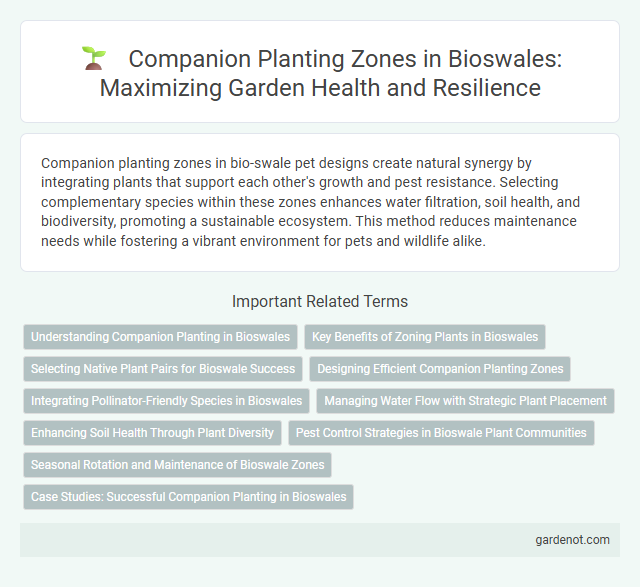Companion planting zones in bio-swale pet designs create natural synergy by integrating plants that support each other's growth and pest resistance. Selecting complementary species within these zones enhances water filtration, soil health, and biodiversity, promoting a sustainable ecosystem. This method reduces maintenance needs while fostering a vibrant environment for pets and wildlife alike.
Understanding Companion Planting in Bioswales
Companion planting in bioswales enhances soil health and water filtration by strategically pairing plants with complementary root structures and nutrient needs. Selecting diverse species that attract beneficial insects and improve microbial activity supports pollutant breakdown and erosion control in bio-retention areas. Optimizing plant combinations strengthens the bioswale's ecological function and resilience in managing stormwater runoff.
Key Benefits of Zoning Plants in Bioswales
Zoning plants in bioswales enhances water filtration by clustering species with complementary root structures that improve soil permeability and pollutant uptake. Grouping native plants in specific zones supports biodiversity, promotes habitat stability, and increases resilience to environmental stressors. This strategic planting reduces maintenance needs by optimizing plant health and minimizing invasive species encroachment.
Selecting Native Plant Pairs for Bioswale Success
Selecting native plant pairs for bioswale success enhances water filtration and erosion control by leveraging complementary root structures and growth habits. Deep-rooted species like switchgrass (Panicum virgatum) combined with shallow-rooted plants such as New England aster (Symphyotrichum novae-angliae) improve soil stability and nutrient uptake. This companion planting strategy promotes biodiversity and resilience in bioswale ecosystems while optimizing stormwater management.
Designing Efficient Companion Planting Zones
Designing efficient companion planting zones in a bio-swale maximizes plant health and stormwater management by pairing species that enhance nutrient uptake, pest control, and root structure stability. Incorporating native plants such as milkweed alongside water-tolerant species like cattails supports biodiversity and improves filtration efficiency. Strategic spatial arrangement reduces competition for sunlight and water, promoting synergistic growth and increasing the swale's overall ecological function.
Integrating Pollinator-Friendly Species in Bioswales
Integrating pollinator-friendly species in bioswales enhances biodiversity and supports local ecosystems by attracting bees, butterflies, and other pollinators. Selecting native flowering plants such as milkweed, coneflowers, and bee balm within companion planting zones promotes pollination and improves water filtration effectiveness. These plants not only sustain pollinator populations but also contribute to the bioswale's resilience and overall environmental health.
Managing Water Flow with Strategic Plant Placement
Companion planting in bio-swales enhances water management by strategically placing deep-rooted plants to improve soil infiltration and reduce runoff. Native grasses and sedges absorb excess water, while moisture-loving species stabilize banks, minimizing erosion and supporting efficient water flow. This targeted plant arrangement optimizes stormwater capture, promoting groundwater recharge and maintaining ecosystem health.
Enhancing Soil Health Through Plant Diversity
Companion planting in bio-swales fosters diverse plant species that improve soil structure and nutrient cycling. Deep-rooted plants in the zone enhance microbial activity and increase organic matter, promoting soil aeration and water infiltration. This plant diversity supports natural pest control and reduces the need for chemical inputs, sustaining long-term soil health.
Pest Control Strategies in Bioswale Plant Communities
Companion planting in bioswale ecosystems enhances pest control by integrating plant species that naturally repel or attract beneficial insects, reducing reliance on chemical pesticides. Strategic selection of pest-resistant plants and those that support predatory insects creates a balanced microhabitat, promoting ecological stability. This approach optimizes bioswale functionality by maintaining plant health and improving water filtration through sustainable pest management.
Seasonal Rotation and Maintenance of Bioswale Zones
Seasonal rotation in companion planting zones of bioswales enhances soil health by alternating deep-rooted plants with nitrogen-fixing species, promoting nutrient cycling and microbial diversity. Maintenance involves regular monitoring of plant health, removal of invasive species, and mulching to retain moisture and suppress weeds, ensuring optimal water filtration and pollutant removal. Effective management of bioswale zones supports stormwater control, reduces erosion, and improves habitat for beneficial insects.
Case Studies: Successful Companion Planting in Bioswales
Case studies demonstrate that companion planting in bioswales enhances stormwater management and biodiversity by integrating species like native grasses, flowering perennials, and nitrogen-fixing legumes. Research in urban environments shows that combining deep-rooted plants such as switchgrass with pollinator-friendly plants like purple coneflower improves soil stabilization and pollutant filtration. These successful models highlight optimized plant selection for maximizing water infiltration and ecosystem resilience in bioswale systems.
Companion planting zone Infographic

 gardenot.com
gardenot.com